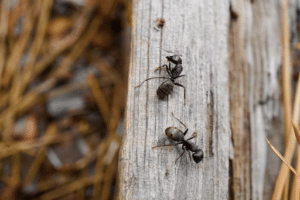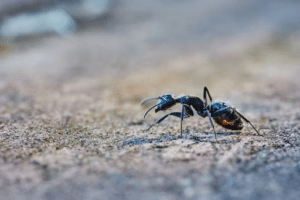
If you live in the Chicago area, you most likely have experienced the frustration of dealing with ants at some point in your life.
These small yet persistent pests can infiltrate your home in droves, causing extensive damage (in some cases) and unsanitary conditions.
The good news is that there are steps you can take both to prevent ant infestations from happening in the first place and to treat them when they do occur.
If you’re looking for tips on ant control in Chicago, you’re in the right place. Keep reading for our best tips!
How Common Are Ants in Chicago?
If you’re researching ant control in Chicago, there’s a good chance that you already know how big of a problem these teeny tiny pests are here in the windy city.
Of the 90 species of ants found in Illinois, several species are commonly found in Chicago. These include acrobat ants, Argentine ants, carpenter ants, citronella ants, field ants, pavement ants, odorous house ants, pharaoh ants, and small honey ants.
Each of these ants has unique characteristics that distinguish them, but they all have the potential to become a nuisance if they infest your home or business.
Argentine ants are some of the most commonly encountered ant species in Chicago. These ants are small and brown in color, and they form large colonies with multiple queens. They are known for their persistent foraging behavior, which can make them a nuisance to homeowners seeking to keep their kitchens and pantries clean.
Carpenter ants are another common species in Chicago and can cause significant damage to wooden structures, especially if left untreated.
One ant species you’re unlikely to find in Chicago is the fire ant. Fire ants are a significant problem in the southern parts of the United States because of their aggressive nature and painful sting. These ants have not yet made their way to Illinois, but it’s possible they could eventually migrate to the area.
If you’re dealing with an ant infestation in your home or business, it’s important to take action quickly to prevent it from getting worse. More on this below!
How to Prevent Ants
When it comes to ant removal in Chicago, an ounce of prevention is worth a pound of cure – or so the saying goes! Here are some effective methods to prevent ants from invading your home.
1. Cut Off the Food Source
One of the main reasons ants invade your home is because they’re searching for food and water. The first thing you can do to prevent ants is to make sure your kitchen and dining areas are always clean and free of crumbs and spills.
Don’t leave food out on the counters. Sweep the floors and wipe down surfaces after meals. Similarly, check your plumbing fixtures for leaks and fix them right away – water can attract ants just as easily as food.
2. Seal Up Entry Points
Another way to prevent ants from entering your home is to seal off their entry points. Ants can enter through the smallest cracks and gaps in your walls, floors, doors, and windows. Inspect your home for any potential entry points, and seal them with caulk or weather-stripping.
Keep your doors closed, and use door sweeps or thresholds to prevent ants from sneaking under the door.
3. Store Food Properly
Another proactive measure that you can take to prevent ants is to store your food properly. Keep your food in airtight containers to minimize any odor or moisture that can attract ants. This applies particularly to pantry items such as dry cereal, flour, sugar, and pet food.
By doing this, you can eliminate the most inviting reason for ants to invade your kitchen.
4. Keep a Clean Garden
Ants can also be a problem in your outdoor areas, such as your garden or patio. To prevent ants from making their home in your yard, keep it clean and tidy. Remove any debris and clutter, and keep plants and trees trimmed.
Also, make sure you avoid leaving food waste or pet food outside, as this can attract ants.
Tips for Eliminating Ant Colonies
While you can usually keep ants out of your house by following the preventative tips listed above, unfortunately, they’ll sometimes still get past you. If you’re finding yourself with an ant infestation despite your best efforts to prevent it, there are a few things you can do.
The first step you should take is to find the colony. Ants have a nesting pattern where they form a queen ant, several worker ants, and larvae. They form their colonies in hidden places like under the floor cracks or walls. Once you detect the colony’s location, you need to place your treatment solution there. Sometimes, they can also form a satellite nest. To locate this, all you need to do is follow the ant trail.
Once you’ve figured out where the ants are, it’s time to apply a treatment. Ant baits or insecticides are good choices. Ant baits, for example, work by attracting ants to a poison-laced bait. The worker ants eat the bait and bring it back to their colony. Once the queen ant and larvae consume the bait, it will gradually kill off the entire ant colony.
Who Offers the Best Ant Control in Chicago?
Looking for ant removal in Chicago?
If you have a large or persistent ant infestation, or if you’re not sure what type of ant species you’re dealing with, it’s always a good idea to call in a professional pest control company rather than trying to tackle the problem yourself.
At Hawx Pest Control, we have extensive experience dealing with ant problems in Chicago and can offer a customized treatment plan to fit your specific needs.
Ant problems can be frustrating, but they don’t have to take over your home or business. By taking steps to prevent ants from entering in the first place and by using the right treatment methods, you can effectively manage and eliminate ant infestations.
Contact Hawx Pest Control today to join our growing family of satisfied customers.
Categories
RELATED POSTS





